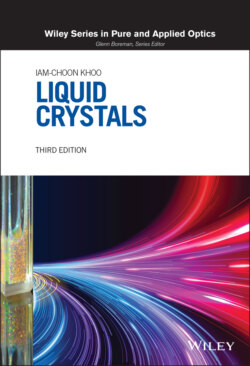Читать книгу Liquid Crystals - Iam-Choon Khoo - Страница 40
2.4.2. Free Energy in the Presence of an Applied Field
ОглавлениеIn the presence of an externally applied field (e.g. dc or low‐frequency electric, magnetic, or optical electric field), a corresponding interaction term should be added to the free energy.
For an applied magnetic field H, the energy associated with it is
(2.25)
where M is the magnetization given by
(2.26)
Thus
(2.27)
Using Eq. (2.9), we can rewrite Fint as
(2.28)
The first term on the right‐hand side of Eq. (2.28) is independent of the orientation of the (anisotropic) molecules, and it can therefore be included in the constant F0.
On the other hand, the second term is dependent on the orientation of the molecules. Using Eq. (2.10) for the order parameter Qαβ we can write it as
(2.29)
Therefore, the total free energy of a liquid crystal in the isotropic phase, under the action of an externally applied magnetic field, is given by
(2.30)
Without solving the problem explicitly, we can infer from the magnetic interaction term that a lower energy state corresponds to some alignment of the molecules in the direction of the magnetic field (for Δχ m > 0).
Using a similar approach, we can also deduce that the electric interaction contribution to the free energy is given by (in inks units)
(2.31)
The orientation‐dependent term is therefore
(2.32)
where Qαβ is defined in Eq. (2.4).
In Chapter 8, we present a detailed discussion of isotropic phase molecular orientations by an applied optical field from a short intense laser pulse. It is shown that both the response time and the induced order Q depend on the temperature vicinity (T – Tc) in a critical way; they both vary as (T – Tc)−1, which becomes very large near Tc. This near‐Tc critical slowing down behavior of the order parameter Q of the isotropic phase is similar to the slowing down behavior of the order parameter S of the nematic phase discussed in the previous section. Besides the nematic ↔ isotropic phase transition, which is the most prominent order ↔ disorder transition exhibited by liquid crystals, there are other equally interesting phase transition processes among the various mesophases [13], such as smectic‐A ↔ smectic‐C*, which will be discussed in Chapter 4.
